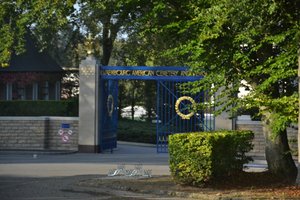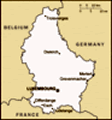Advertisement
Published: June 28th 2022

 Luxembourg American Cemetery
Luxembourg American Cemetery
Entrance to Luxembourg American Cemetery. The cemetery contains the graves of 5,076 service members who were killed in the Battle of the Bulge and the advance to the Rhine during World War II. Established in 1944 and dedicated in 1960.
DSC_0313Our hotel in Luxembourg, the Novotel, was located in the Kirchberg neighborhood. The Kirchberg Plateau is an area in northeast Luxembourg-Ville. It is not as well known by visitors as the historic center of the old city. Kirchberg was once part of the Luxembourg's extensive fortress complex and housed Fort Thungen. From the demolition of the fortifications in 1867 to the post-World War 2 period, Kirchberg was a rural residential suburb. Modern development of the area began in 1963 with the opening of the stylish red Grande-Duchesse Charlotte Bridge between Kirchberg and the old city. (Try as I might, I could not get a photo of it!) Kirchberg soon became a banking center and then a center for the European Union with the construction of EU agency headquarters and office buildings in the 1990s. There was only one tall building in the vicinity when I visited Luxembourg in 1970. Now it was the center of the action. Parks and modern public sculpture have been added to round out the cityscape, so that Kirchberg today is a very modern looking part of the city. I'm reminded of the planned development of Brasilia. It's still under construction too, as roads around the hotel

 Memorial Chapel
Memorial Chapel
Memorial Chapel. Luxembourg American Cemetery. The cemetery contains the graves of 5,076 service members who were killed in the Battle of the Bulge and the advance to the Rhine during World War II. Established in 1944 and dedicated in 1960.
DSC_0314were torn up with additions to the Konrad Adenauder Building, the Secretariat of the European Parliament, in progress. A map at the hotel showed the many planned additions to Kirchberg. Many public facilities, such as the Bibliothèque nationale de Luxembourg, are moving here from the historical center.
Wednesday morning sightseeing in Luxembourg began with a drive through the Kirchberg. I enjoyed seeing all the variations of modern architecture on display here. The best was the air filter-shaped Luxembourg Philharmoinie concert hall. I hoped one of these modern buildings would turn out to be a library, but not so.
Our next objective was to visit the Luxembourg American Cemetery. The cemetery, containing 5,074 American war dead, was established in 1944 and formally dedicated in 1960. It is the burial place of George S. Patton. The grounds include a Memorial Chapel and panels depicting the Battle of the Bulge and the Rhineland Campaign. Interments are are from those theatres of the war.
Next, we returned to the historical part of the city to drive through the Casemates du Bock, but not visit them. (I was able to explore inside the fortifications in 1970.) Luxembourg's cliffside fortifications were built between

 Memorial Chapel
Memorial Chapel
Memorial Chapel. Luxembourg American Cemetery. The cemetery contains the graves of 5,076 service members who were killed in the Battle of the Bulge and the advance to the Rhine during World War II. Established in 1944 and dedicated in 1960.
DSC_0315the 16th century and 1746 variously by the Spanish, French, and Austrians. The fortifications offered a commanding view of the Alzette and Petrusse river valleys from the plateaus of Luxembourg. There were three rings of fortifications facing each direction. All of them were dismantled following the Treaty of London of 1867, though ruins remain throughout the city. Luxembourg City is built on several plateaus, with the Alzette and Pétrusse rivers cutting wide valleys between them. (Hence the Bock Casemates defensive fortifications looked out upon the valley of the Alzette and the Pétrusse Casemates over the valley of the Pétrusse.) Two long railway viaducts cross the river valleys. The coach let the group off at Constitution Square for a walking tour of the Upper Town (
Haute Ville).
In Constitution Square is the prominent Monument of Remembrance. It was erected to commemorate Luxembourg casualties in World War I. In 1984, the monument was reconstructed and also commemorates Luxembourgians of World War II and the Korean War. Crossing Boulevard Franklin D. Rosevelt, we came to the Luxembourg Cathedral. The cathedral (
Notre-Dame de Luxembourg) was originally a Jesuit church, begun in 1613 and completed in 1621. The church is very late Gothic, almost

 Luxembourg American Cemetery
Luxembourg American Cemetery
Luxembourg American Cemetery. The cemetery contains the graves of 5,076 service members who were killed in the Battle of the Bulge and the advance to the Rhine during World War II. Established in 1944 and dedicated in 1960.
DSC_0316Neo-Gothic. It was made a cathedral in 1870. Adjacent to it was the Collège jésuite, the buildings used as the National Library until 2014.
From the cathedral, it was a short walk to see the exterior of the Grand Ducal Palace and then on to Place Guillaume II. An equestrian statue of William II if the focus of the large open square. William II (1792-1849) was King of the Netherlands and Grand Duke of Luxembourg. The group dispersed here for lunch and free time to explore. A farmer's market was in progress on the square and we took time to have a look at it.
Susan and I then enjoyed lunch at a sidewalk cafe in Rue du Marché-aux-Herbes within sight of the Gand Ducal Palace. At a nearby table, a film crew was filming a woman sampling different foods. Perhaps for an advertisement or tourism promotion video? In any case, I guess this was the place to be! Nearby was the Chocolate House of Luxembourg. For dessert, we tried a Hot Chocolate Spoon. This is a wooden spoon dipped in chocolate. You then dip it into warm milk and let the chocolate dissolve. Yum!
The Hatue-Ville

 George S. Patton
George S. Patton
Grave of General George S. Patton (1885-1945). Luxembourg American Cemetery.
DSC_0323(old town) and Casemates du Bock are part of the City of Luxembourg: its Old Quarters and Fortifications UNESCO World Heritage site.
The arranged meeting place for the group was the Place des Arms. To get there, Susan and I walked along Grand Rue, Luxembourg's principal shopping street. Grand Rue is a pedestrian precinct today, lined with name brand shops and stores. Once the group reassembled at Place des Arms, we returned to Constitution Square where the motorcoach picked us up.
The group was back at our hotel by 2:30. Just in time to refresh for the late afternoon excursion over to Trier, Germany.
Advertisement
Tot: 0.143s; Tpl: 0.016s; cc: 16; qc: 36; dbt: 0.0919s; 1; m:domysql w:travelblog (10.17.0.13); sld: 1;
; mem: 1.2mb
























D MJ Binkley
Dave and Merry Jo Binkley
Cemetery
The cemeteries are always somber.